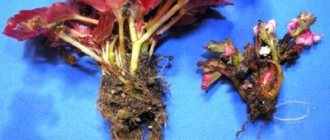- October 27, 2018
- Houseplants
- Svetlana Syabitova
This plant can decorate not only the garden; a large number of varieties have been bred to decorate residential and office spaces. Even novice flower growers can grow indoor lilies, photos and names of varieties of which can be found in the article. The plant is widely used in cosmetology and medicine. The bulbs of some species are quite edible, which is what small rodents, such as mice and squirrels, use.
Classification of indoor lilies
At home, lilies of a wide variety of colors, sizes and shapes are grown. Many varieties are specially bred for indoor floriculture. The most commonly used classification is based on the shape of the flower's petals. Below are photos and names of domestic lilies, or rather, the most popular varieties:
- the cup-shaped flowers are known as the Grand Commander, Gilded Lily, Belle Lily and Empress of China varieties;
- funnel-shaped petals - this species is represented by the largest number of varieties, for example, Royal Lily, Royal Gold;
- the flowers have bent petals, there are not very many varieties of this species, there are dwarf ones, Citronella.
Asian hybrids can be distinguished as a separate group; a distinctive feature of this group is the absence of odor. These are decorative species, with flowers of various colors, they can have stripes, spots, specks - beautiful house lilies, photos and names of which are also presented in the article. This species is highly resistant to diseases and is less susceptible to pests.
Curly hybrids with amazing flower shape. They need a little more moisture; they love leaf humus. For beginning flower growers, it is recommended to choose hybrid varieties; they are best adapted to home conditions.
Amazonian white indoor lily, photo and name, which is most often indicated in reviews of gardeners, has beautiful 15 cm flowers and a delicate aroma.
Sometimes lilies are confused with amaryllis. The main difference is the time of flowering: amaryllis blooms in winter, lilies bloom in summer and autumn.
Planting indoor lilies
You can plant a plant yourself, but to do this you need to know how to do it correctly. First of all, you need to take care of the planting material. Bulbs are most often used, but seeds can be taken. First you need to get acquainted with the Indoor Lily flower, the photo and name of each variety, which, as a rule, are indicated in the annotation for the bulbs. The best time to purchase is autumn. It is important to pay attention to the quality of the bulbs; they should be smooth, dense, without scales or spots. Before planting, the material should be treated with a solution of potassium permanganate.
What matters is the size of the container in which the lily will grow. The pot should be deep, and the width should be calculated so that there is a distance of 3 cm from the bulb to the edge of the pot. Most often, containers with a diameter of 15 cm are used. If you choose a pot that is too large, the lily may not bloom at all.
Procedure for planting lily bulbs:
- Make drainage at the bottom of the pot: expanded clay and small stones will do.
- Sprinkle 5 cm of soil on top for bulbous plants; it should be light and nutritious.
- Place the onion in the center, carefully straightening its roots.
- Add soil and compact it slightly. As a result, the bulb should be placed in the ground to half its height.
- Moisten a little.
You can make the soil for indoor lilies yourself; for this you need to prepare the following composition: 3 parts of turf soil, 1 part each of river sand, humus, leaf soil.
The pot with the plant should be placed in a cool and well-lit place. After some time, the first shoots will appear, after which the lily is transferred to a permanent place.
You can plant several bulbs of the same variety in one container, but with different flower colors. As a result, during flowering you will get a very beautiful composition. You can see photos of domestic lily flowers that look spectacular in group plantings below.
Botanical description
Lily is a perennial bulbous plant that has a leafy, non-branching stem. Its height can vary from 15 cm to 2 m depending on the variety and variety.
In some varieties and species, aerial bulbs develop in the axillary sections of the leaves. The flowers are collected in umbellate, corymbose, paniculate or racemose inflorescences, which consist of 3-40 flowers.
The flowers differ in their shape. They can be star-shaped, bell-shaped, tubular, turban-shaped or cup-shaped. Their size varies from 3 to 20 cm. The buds are single-color or two-color.
Read about varieties that are suitable for home cultivation here.
Plant care
For normal growth and abundant flowering, it is necessary to create favorable conditions for indoor lilies. When purchasing an indoor lily, a photo, name and care are included with the planting material. You should pay attention to them. Some varieties have slight distinctive features in their content. If everything is done correctly, the plant will not be affected by diseases and pests.
At the very beginning of growth, the flower needs a temperature of +10°C, after it has reached a height of 10 cm, it must be moved to a lighted place with a temperature of +16°C, but no more.
Later, for the growth of an adult plant, a temperature of +25 ° C and a lot of sun will be required. Lily is not afraid of direct sunlight, so it feels great on southern windows, and in the summer on balconies and loggias.
The indoor lily needs regular watering, but does not tolerate stagnation of water. It is necessary to water the plant as soon as the top layer of soil dries slightly. Water needs to be at room temperature. Experienced flower growers recommend watering the lily a little every morning and evening in the spring and summer.
If the room temperature is too high, spraying should be carried out. It must be remembered that lilies do not need too high humidity. To remove dust from the plant, you should wipe the leaf blades with a damp sponge once a week.
When buds appear, it is necessary to tie the plant to a support. The photo below shows how to do this correctly with house lilies.
Which container should you choose?
It is very important to choose the right size pot. The taller the flower, the taller and wider the container should be. For example, if the stem reaches a height of 150 cm, then the container should be at least 35 cm.
One plant requires 16 square meters. cm area of the pot. Based on this, it can be calculated that 3-4 bulbs can be planted in a container with a diameter of 40 cm. It is not advisable to plant only one sprout in a container. It's less beautiful.
If there is too much soil, the plant will actively produce babies, which will negatively affect flowering.
The flower will not begin to bloom until the roots fill the available space.
Feeding
For the normal development and flowering of indoor lilies, additional nutrition is necessary; if there is a lack of it, buds may not form. It must be remembered that active growth requires nitrogen fertilizers, and for flowering potassium and phosphorus fertilizers should be applied.
The plant responds well to organic fertilizing, therefore, starting in spring, you can apply slurry, which is diluted with water in a ratio of 1 to 10. This fertilizer should be done once every three months.
It is best to feed the plant according to this scheme:
- the first feeding is done at the beginning of growth;
- the second during the formation of buds;
- the third is introduced after flowering.
In addition, you can add wood ash to the soil throughout the season. The indoor lily will decorate any room; photos of the best specimens can often be found in reviews of flower growers.
How to care in winter?
In plants living in different conditions, the number of dormant periods and the time of their onset may vary.
The plant itself tells you when it’s time to rest. After the appearance of new leaves and the end of flowering, eucharis seems to freeze for two to three months.
IMPORTANT! At this time, the application of fertilizers is strictly prohibited. Water the flower moderately, only when the earthen ball dries out to two-thirds of the pot's capacity, while preventing the leaves from withering.
Failure to comply with these conditions leads to the fact that the Amazon lily stops blooming.
The end of the dormant period is signaled by the growth of young offspring.
Obtaining indoor lilies from seeds
You can grow indoor lilies from seeds; the process is more labor-intensive and time-consuming. But the result will be a large number of plants that will be adapted to your conditions. First of all, you should take care of the planting material for indoor lilies, look at the photo and name in the article, and choose the most suitable option. After this, in order to get a healthy and beautiful plant, you should pay attention to the recommendations of gardeners.
Tips for growing lilies from seeds:
- their germination temperature is 20-25°C, different varieties may differ slightly;
- germination depends on the time of seed collection, the shelf life of planting material is no more than two years;
- no pre-treatment with cold is required;
- to speed up seed germination, you need to soak them for 15 hours;
- the best time for planting is February-March;
- soil composition: sand, peat, humus, garden soil;
- seed placement depth 0.5 cm;
- containers for planting should be selected with a height of about 10 cm;
- as soon as seedlings appear, the plants should be accustomed to normal conditions;
- diffused sunlight is required;
- do not allow the soil to dry out;
- When the first shoots appear, you need to reduce the temperature to 15-20°C.
As soon as the first true leaves appear, the plants should be transplanted into separate pots.
This process takes a lot of time and certain skills are required, so it is better for novice gardeners to purchase bulbous planting material.
What to look for when purchasing?
It is recommended to purchase seed from mother bushes that are at least 3 years old. High-quality “babies” will have a uniform structure with a smooth surface and are hard to the touch.
You should not buy “babies” with damaged scales, deformed parts, or various stains.
You can buy a baby with leaves on it, and even shoots, but it must be immediately planted in a pot and fertilized.
Planting material
What to do with a lily when it has bloomed
Beginning flower growers are often faced with the fact that the indoor lily has a flower (photo presented) with yellowed leaves and stem. How to help a plant in such a situation?
After lush flowering, a dormant period begins, at which time the entire above-ground part of the plant completely dies. Yellowed stems should not be cut off. During this period, you need to water once a week; the remaining nutrients in the leaves and stem will go into the bulb. As soon as the leaves and stem are completely dry, stop watering.
You can place the bulbs in a bag with wet sawdust and moss and put them in the refrigerator. It is better to place it in another place where the temperature will be +4-6°C.
Why did the lily turn yellow?
Lily demands attention. The indoor lily has turned yellow, a photo of the flowers can be seen below. Novice gardeners are wondering what can be done, how to save the plant? It is necessary to understand why this happened.
Causes of yellowing of leaves and stems:
- Autumn has come;
- watered incorrectly;
- the surrounding air is too dry;
- insufficient nutrition.
If the lily turns yellow in the fall, then this is normal. If there are errors in care, it is necessary to humidify the air, water it in the morning and evening, and feed it with fertilizers that contain potassium and iron.
Why doesn't the lily bloom?
We purchased a homemade lily, the photo on the package promised the appearance of a beautiful flower, but there were no buds for a long time. Why is this happening and what should be done?
The lily does not bloom for the following reasons:
- lack of food;
- not enough moisture;
- little sun;
- The container in which the onion was placed is too large.
It is necessary to change the conditions of maintenance and the indoor lily will bloom. Home care and photos of a specific variety can be found in the reports of flower growers. Increase the amount of fertilizing, water well, ventilate more and move the plant to a sunny windowsill. If the container for the plant was chosen too large, then the lily uses it for propagation: it forms new bulbs.
Amaryllis
It's not for nothing that belladonna is actually called the belladonna lily, because they are remarkably similar. This is a moisture-loving large plant, the buds of which open up to 12 cm in diameter.
Photo: goodfon.ru
Types and varieties of daylily: photos, names and descriptions
Helpful information
When growing indoor lilies, a variety of situations can arise, so you may need the following advice from experienced gardeners:
- if in the summer the plant is taken out onto the balcony, terrace or garden, care should be taken to ensure that during rain the drops do not fall on the “pet”;
- in a sick, weakened plant, all buds must be removed;
- in the first year of life, flower ovaries need to be pruned;
- During the formation of buds, watering should be increased slightly.
Diseases and measures to combat them
House lilies can be affected by a variety of diseases, both fungal and viral. Their appearance is associated with violations in the maintenance of green “pets”. In addition, you can purchase planting material that was stored incorrectly or was infected with certain fungal diseases.
The most common diseases of indoor lilies:
- Botrytis is popularly known as gray mold.
- Fusarium, most often called “soft rot”.
- Mosaic.
High humidity is a favorable condition for the development of fungal spores; the plant becomes sick with gray rot.
External signs of Botrytis disease:
- first, small yellow spots appear on the bottom of the leaf blade;
- the affected area increases;
- the color of the spots becomes gray, these areas appear fluffy;
- rot spreads to the stem and then to the bulb;
- the above-ground part of the plant turns brown and falls off.
Infected domestic lily flower (photo can be seen below). It is easier to prevent the disease using preventive measures, avoiding stagnation of water and high humidity. To prevent the spread of the disease, all affected parts of the plant must be cut off and disposed of. You can try to save the bulb. To do this, remove the plant from the pot, rinse with water, and soak for half an hour in a 0.5% Fundazol solution. Plant in new soil.
Fusarium, popularly known as soft rot, resembles Botrytis in its external signs of damage to the above-ground part of the plant. You can distinguish them by the condition of the bulb. Black, watery spots form on the scales. The bulbs quickly become moldy and soften. The plant should be removed from the pot, all diseased parts should be removed and disposed of. Remove the affected areas of the onion, then soak it for 50 minutes in a 0.3% Rogor solution. If the root system is severely damaged, the plant cannot be saved.
Most often, the house lily is affected by the mosaic viral disease. They can easily infect lilies from vegetable and flower crops. In addition, it can be spread by pests: mites, aphids.
Signs of the disease:
- on the leaves you can see spots, most often elongated, white or black and white in color;
- leaves and buds are deformed;
- white stains;
- the stem and leaves rot;
- the upper part of the plant dies.
It will not be possible to save a plant infected with mosaic; it must be disposed of so that the virus does not spread further. A photo of an indoor lily with mosaic disease is presented below.
To combat mosaic, preventive measures are important; before planting the bulbs, they must be soaked in Fitosporin. To prepare it, you need to dissolve 4 drops of the product in 200 ml of water.
Pests of indoor lilies
Both garden and indoor lilies can be attacked by harmful insects. Pests damage plants and buds, draw out juices, and infect them with various diseases.
The most common pests of indoor lilies:
- aphid;
- spider mite;
- scale insect;
- mealybug.
Harmful insects can appear if the conditions for keeping the plant are not met; the lily can become infected with them from other indoor plants. Insecticides are used to control pests.
Lily is one of the most beautiful flowers that decorate parks and gardens. There are a large number of varieties bred specifically for growing at home. Lilies are valued for their beautiful flowers of different shapes, shades and sizes. Growing lilies is not difficult, you just need to create the necessary conditions for it.
History of origin
If we talk about a plant like a lily, the indoor flower appeared relatively recently - before that, only outdoor varieties were known.
This is a hybrid that was obtained in the 50s of the 20th century by crossing different types of lilies growing in open ground.
The creators of the home flower are Dutch breeders who were able to give it the features necessary for growing in a pot.
Today, even novice flower lovers can grow a lily in a pot. Moreover, they have a choice: you can buy agapanthus, amaryllis, hymenocallis or eucharis.











